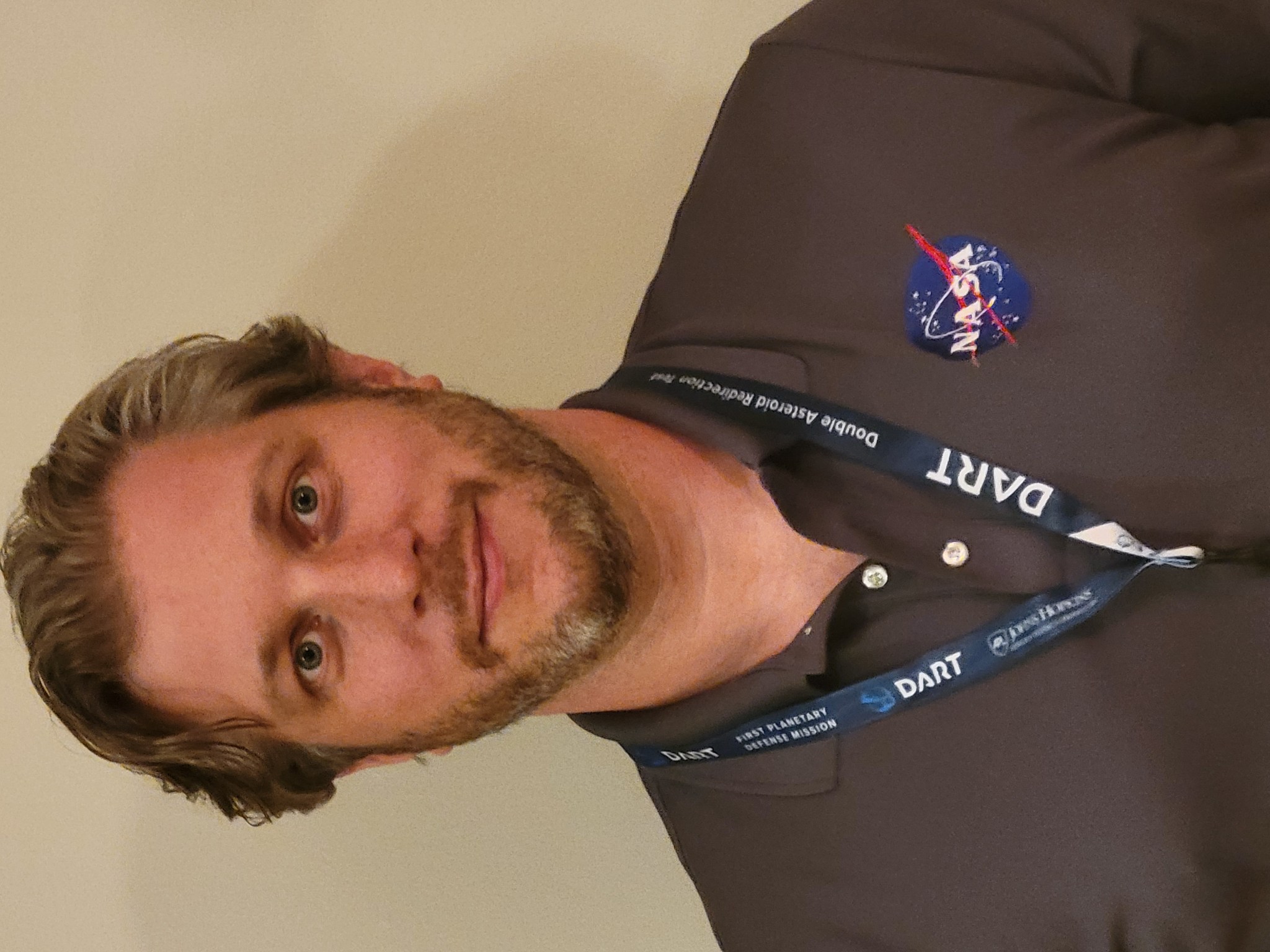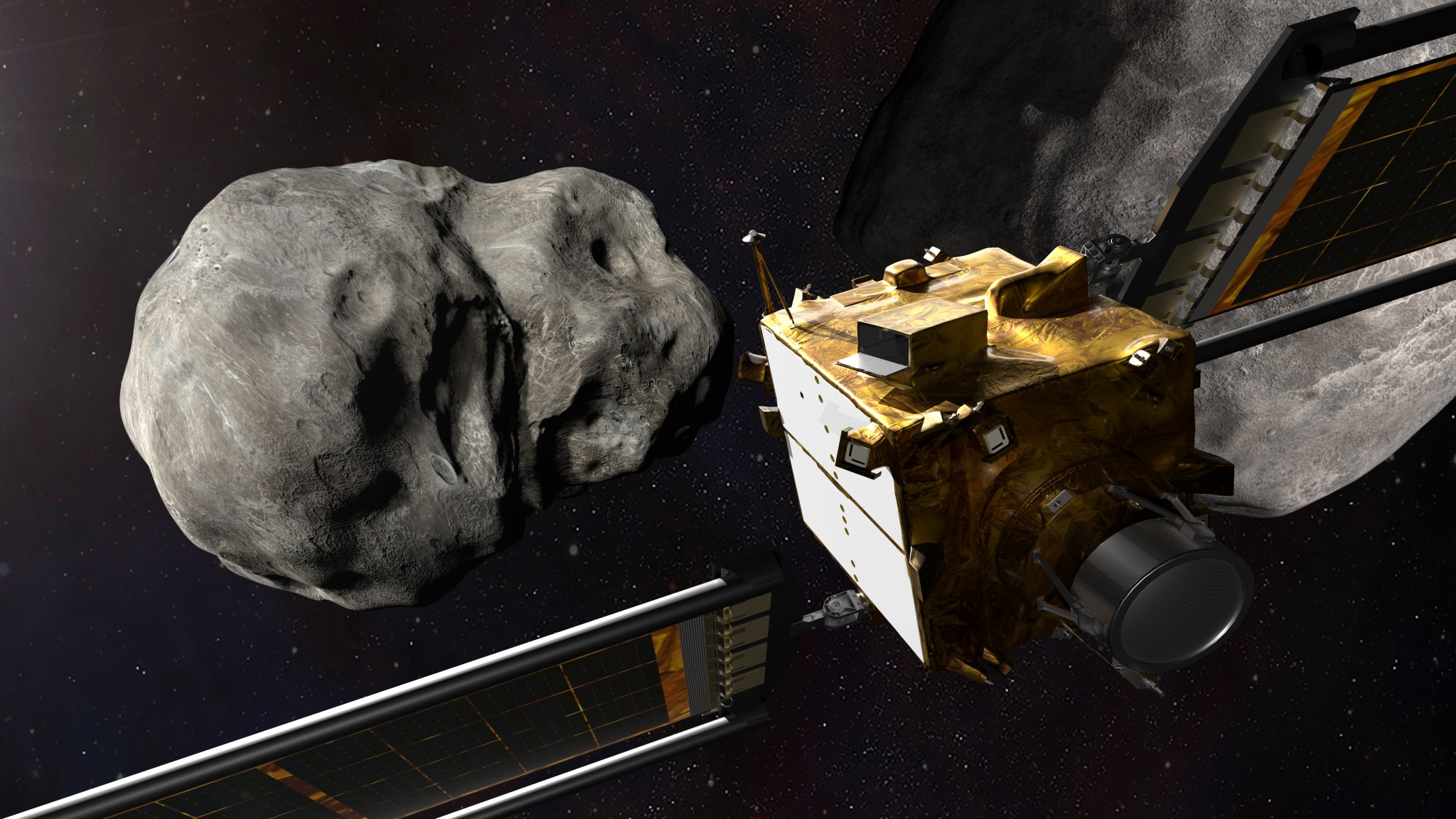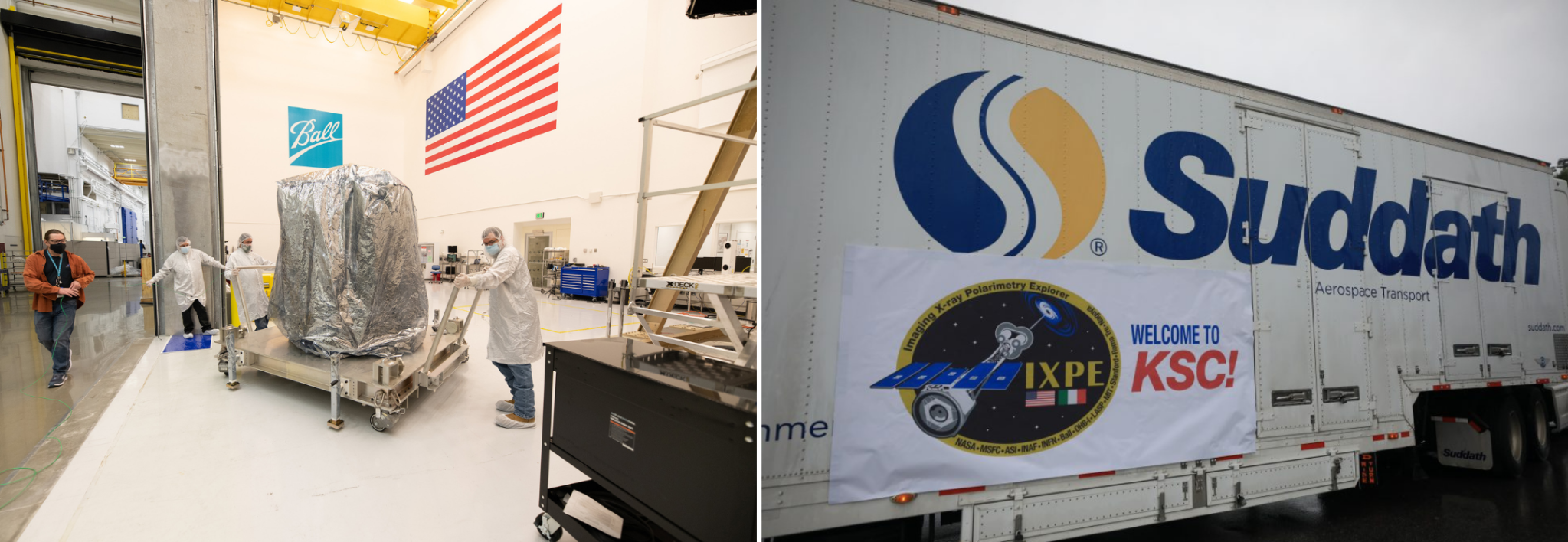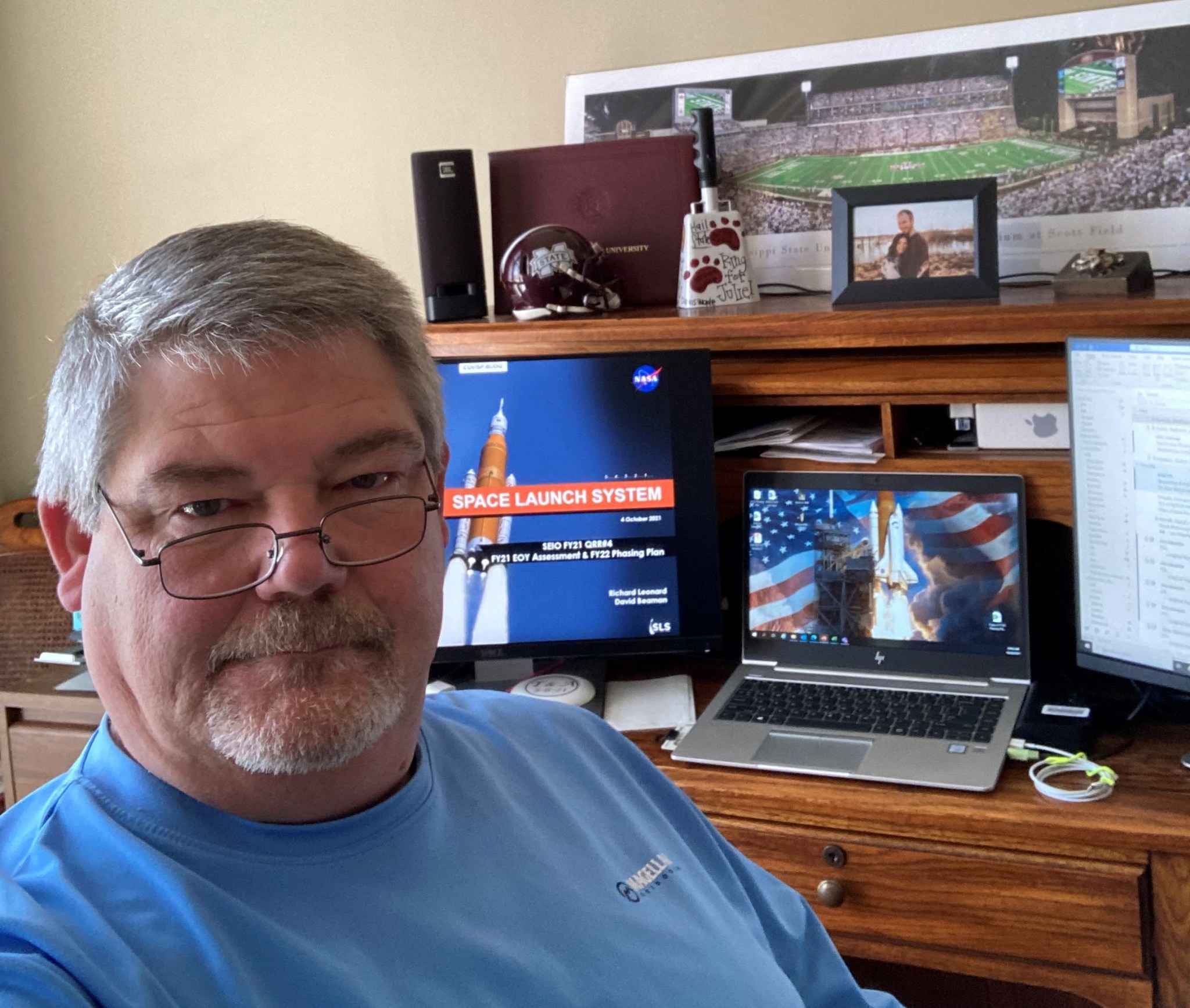DART on Target: Six Questions with Mission Manager Clayton Kachele
By Wayne Smith
It sounds like a plot for a movie, but protecting Earth from a potential impact by a hazardous asteroid is the objective of an upcoming NASA mission.
The Double Asteroid Redirection Test (DART) mission is a planetary defense-driven test of technologies for mitigating such a threat. DART’s target asteroid is not a threat to Earth. The DART spacecraft launch window opens Nov. 24. It will launch aboard a SpaceX Falcon 9 rocket from Vandenberg Air Force Base in California.
The Johns Hopkins Applied Physics Laboratory has been directed to manage the DART mission for NASA’s Planetary Defense Coordination Office as a project of the agency’s Planetary Missions Program Office, which is at Marshall Space Flight Center. The agency provides support for the mission from several centers, including the Jet Propulsion Laboratory, Goddard Space Flight Center, Johnson Space Center, Glenn Research Center, and Langley Research Center. The launch is managed by NASA’s Launch Services Program, based at the agency’s Kennedy Space Center.
Clayton Kachele, mission manager at Marshall for DART, answered several questions about the mission.
Question: What will the DART mission do?
Kachele: DART is the first technology demonstration of the kinetic impactor technique that could be used to mitigate the threat of an asteroid hitting Earth. The kinetic impactor mitigation technique is the impulsive deflection of the asteroid through the sudden addition of momentum. In simpler terms, DART is being sent to collide with an asteroid to change its orbital period.
DART will target Dimorphos, the much smaller “moonlet” of a binary (two-body) asteroid system. Didymos, the primary body, safely orbits the Sun and comes close enough to Earth such that scientists can observe it using ground-based telescopes. The dynamic of the binary asteroid allows DART to impart a change of velocity that can be measured within the asteroid system. Didymos’ pass by Earth in fall 2022 allows astronomers to observe the impact and its aftermath with ground- and space-based telescopes. Didymos is about 2,560 feet in diameter, while Dimorphos is about 530 feet across.
Didymos is not currently a threat to Earth, and the DART demonstration has been carefully designed to make sure it doesn’t create a threat. The impulse DART delivers to the Didymos binary asteroid system is low and Didymos’ orbit around the Sun does not intersect Earth’s at any point in current predictions. This test is a demonstration of a deflection capability to respond to a potential asteroid impact threat, should one ever be discovered.
Question: What kind of instruments are on DART?
Kachele: DART is a simple spacecraft. It carries a single instrument – the Didymos Reconnaissance and Asteroid Camera for Op-nav – an imaging camera derived from the Long Range Reconnaissance Imager on NASA’s New Horizons spacecraft. DRACO will not only image both bodies in the Didymos system, but also provide optical navigation for DART’s autonomous navigation system.
Question: Why is it important for NASA?
Kachele: DART aligns with two important aspects of NASA’s goals to improve life on Earth: Demonstrating techniques to protect our planet from an asteroid impact and developing technologies that might have further useful applications.
Question: Why is DART important to planetary defense?
Kachele: NASA established the Planetary Defense Coordination Office to manage its ongoing mission of planetary defense. The office’s goals are to provide early detection of potentially hazardous objects, track and characterize the objects, study strategies and technologies for mitigating possible impacts, and play a leading role in U.S. government response planning for an actual impact. DART is the first planetary defense test mission for the office.
Question: What is your job as mission manager and what is your favorite thing about it?
Kachele: As the mission manager, it’s my job to make sure the project team has the resources they need to be successful. It is interesting and captivating work where I can work across the entire team, from technical to procurement, to cost and schedule to mission assurance.
DART is a fascinating mission because it is about the future safety of the Earth. We’ve read about the damage from asteroids, ranging from the dinosaurs to the 2013 Chelyabinsk meteor impact. While the DART story is probably not asteroid-movie worthy, it is amazing being on the ground floor of protecting our planet and future generations.
The DART team has been working remarkably well under uncertain conditions as the project started integration and testing just as the COVID-19 pandemic began. Changes to processes had to be realized and new ideas implemented to be able to finish building the spacecraft and the team pulled through better than anyone could imagine. I am very proud to be a member of the DART team.
Question: What does the Planetary Missions Program Office at Marshall do?
Kachele: The office manages the Discovery, New Frontiers, and Solar System Exploration programs with missions that explore the inner planets, outer planets, the Moon, asteroids, comets, and even targets beyond our solar system. The goal is to enhance the probability of mission success by providing technical oversight, as well as specialized support as needed.
Smith, a Media Fusion employee, supports Marshall’s Office of Strategic Analysis & Communications.
NASA’s IXPE Spacecraft Arrives in Florida Ahead of Kennedy Launch
Left: Workers at Ball Aerospace in Boulder, Colorado, prepare to ship NASA’s Imaging X-Ray Polarimetry Explorer (IXPE) spacecraft. Right: IXPE arrives at Cape Canaveral Space Force Station in Florida on Nov. 5. IXPE will study the polarization of X-rays coming to Earth from some of the universe’s most extreme sources – including black holes and dead stars known as pulsars. NASA’s first mission dedicated to measuring X-ray polarization, IXPE is scheduled to launch aboard a SpaceX Falcon 9 vehicle from Kennedy Space Center’s Launch Complex 39A on Dec. 9. The launch is managed by NASA’s Launch Services Program, based at Kennedy. Final prelaunch testing of IXPE began Nov. 8. The spacecraft is expected to be mated to the rocket during the last week of November. IXPE will fly three space telescopes with sensitive detectors capable of measuring the polarization of cosmic X-rays, allowing scientists to answer fundamental questions about these extremely complex environments where gravitational, electric, and magnetic fields are at their limits. NASA selected IXPE as an Explorers Program mission in 2017. The IXPE project is a collaboration between NASA and the Italian Space Agency. NASA’s Marshall Space Flight Center manages the IXPE mission. Ball Aerospace, headquartered in Broomfield, Colorado, manages spacecraft operations with support from the University of Colorado at Boulder. NASA’s Goddard Space Flight Center manages the Explorers Program for the agency’s Science Mission Directorate. (Ball Aerospace, NASA/Isaac Watson)
NASA’s SpaceX Crew-2 Astronauts Advance Research in Space
After more than six months aboard the International Space Station, the astronauts of NASA’s SpaceX Crew-2 mission returned home Nov. 8. The four crew members – NASA astronauts Shane Kimbrough and Megan McArthur, Japan Aerospace Exploration Agency astronaut Akihiko Hoshide, and European Space Agency astronaut Thomas Pesquet – traveled back to Earth inside a SpaceX Crew Dragon capsule, splashing down in the Gulf of Mexico off the coast of Florida. The crew contributed to hundreds of scientific investigations and technology demonstrations while aboard the orbiting laboratory. This valuable scientific research helps to prepare humans for future space exploration missions while generating numerous innovations and benefits for humanity on Earth. The Payload Operations Integration Center at NASA’s Marshall Space Flight Center oversees all experiments and science communications aboard the space station. (NASA)
Marshall Celebrates Future of Human Exploration with Artemis on the Square
Jody Singer, director of NASA’s Marshall Space Flight Center, discusses the positive impact the Space Launch System and Artemis programs have had on the city of Huntsville during their development, at the kickoff of Artemis on the Square Nov. 6 in downtown Huntsville. Singer was joined on the Madison County Courthouse steps by, from left, Chad Emerson, president and chief executive officer for Downtown Huntsville Inc., Huntsville Mayor Tommy Battle, and Debbie Batson, senior director of large/small business strategic alliances at Teledyne Brown Engineering. “While the whole nation is a part of our mission, here in Huntsville, we have a lot to proud of, with more than 60 years of space exploration in our DNA,” Singer said. “Artemis is NASA’s next great space exploration mission, and this mission will be flown on the Space Launch System rocket, managed right here at Marshall with contributions from suppliers in 45 states across the country. We are grateful to always have the support and backing from our city, our partners, our families, and our communities.” Visitors to the courthouse square enjoyed space exhibits, live music, and activities focusing on the Artemis story. Right: More than 150 attendees don astronaut attire in an attempt to break the world record for most people dressed like an astronaut. To view more photos from the event, visit here. (NASA/Janet Sudnik, Mick Speer)
Richard Leonard Recognized as Space Hero
Richard Leonard is the latest team member from NASA’s Marshall Space Flight Center to be named a Space Hero. Leonard is manager of the Program Planning and Control Office in the Space Launch System program’s Systems Engineering and Integration Office. He has been highly effective in overseeing and managing budget operations for Systems Engineering and Integration, and he continually leads the Program Planning and Control team in successfully producing risk-based top-to-bottom estimates and analysis. Each week, the Exploration Systems Development and Space Operations mission directorates recognize Space Heroes, team members from across the agency who have made vital contributions in their support of NASA’s mission to land the first woman and first person of color on the Moon. (NASA)
Chandra Sees Evidence for Possible Planet in Another Galaxy
Signs of a planet transiting a star outside of the Milky Way galaxy may have been detected for the first time. This intriguing result, using NASA’s Chandra X-ray Observatory, opens up a new window to search for exoplanets at greater distances than ever before.
The possible exoplanet candidate is located in the spiral galaxy Messier 51 (M51), also called the Whirlpool Galaxy because of its distinctive profile.
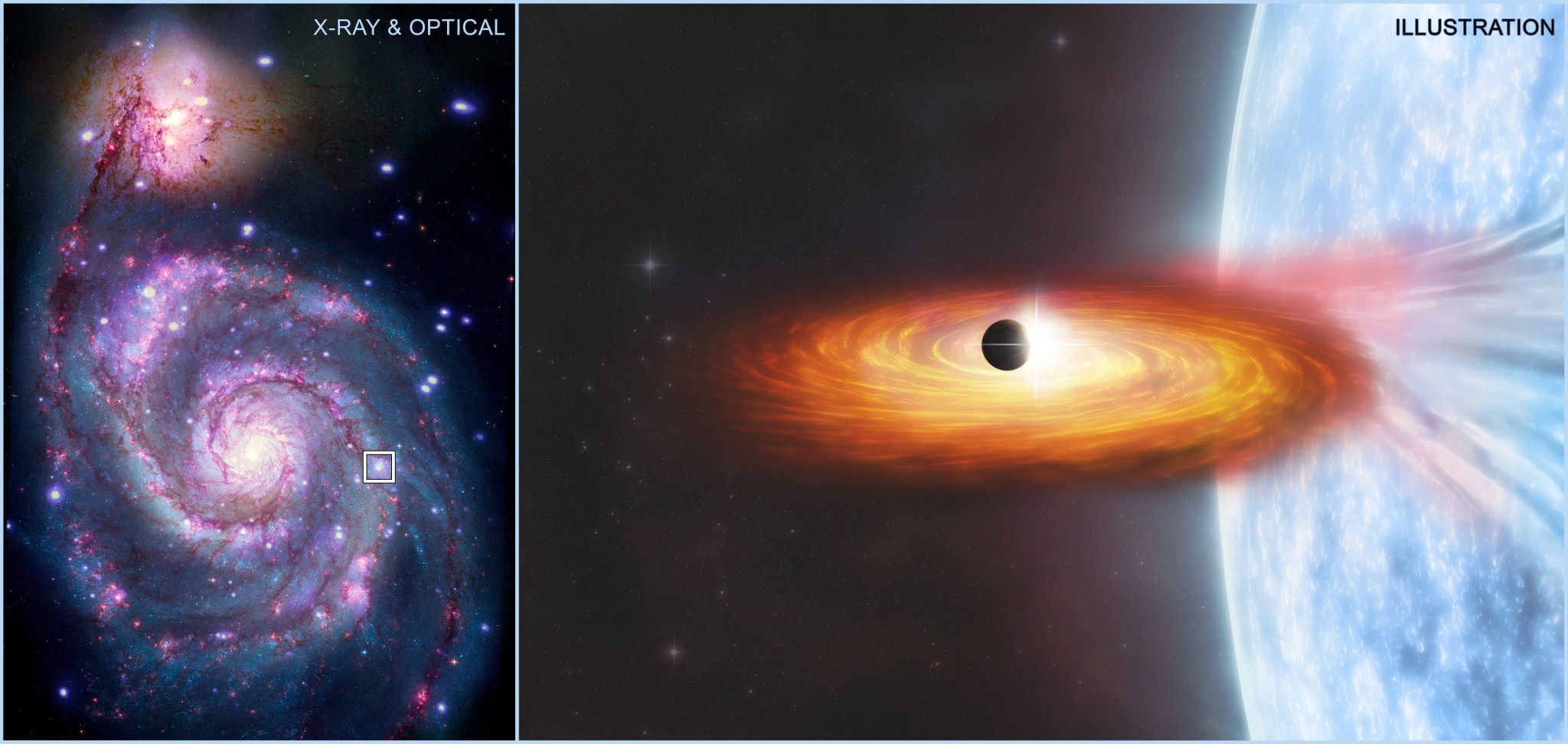
Exoplanets are defined as planets outside of the solar system. Until now, astronomers have found all other known exoplanets and exoplanet candidates in the Milky Way galaxy, almost all of them less than about 3,000 light-years from Earth. An exoplanet in M51 would be about 28 million light-years away, meaning it would be thousands of times farther away than those in the Milky Way.
“We are trying to open up a whole new arena for finding other worlds by searching for planet candidates at X-ray wavelengths, a strategy that makes it possible to discover them in other galaxies,” said Rosanne Di Stefano of the Center for Astrophysics | Harvard & Smithsonian in Cambridge, Massachusetts, who led the study, which was published in Nature Astronomy.
This new result is based on transits, events in which the passage of a planet in front of a star blocks some of the star’s light and produces a characteristic dip. Astronomers using both ground-based and space-based telescopes – like those on NASA’s Kepler and TESS missions – have searched for dips in optical light, electromagnetic radiation humans can see, enabling the discovery of thousands of planets.
Di Stefano and colleagues have instead searched for dips in the brightness of X-rays received from X-ray bright binaries. These luminous systems typically contain a neutron star or black hole pulling in gas from a closely orbiting companion star. The material near the neutron star or black hole becomes superheated and glows in X-rays.
Because the region producing bright X-rays is small, a planet passing in front of it could block most or all of the X-rays, making the transit easier to spot because the X-rays can completely disappear. This could allow exoplanets to be detected at much greater distances than current optical light transit studies, which must be able to detect tiny decreases in light because the planet only blocks a tiny fraction of the star.
The team used this method to detect the exoplanet candidate in a binary system called M51-ULS-1, located in M51. This binary system contains a black hole or neutron star orbiting a companion star with a mass about 20 times that of the Sun. The X-ray transit they found using Chandra data lasted about three hours, during which the X-ray emission decreased to zero. Based on this and other information, the researchers estimate the exoplanet candidate in M51-ULS-1 would be roughly the size of Saturn, and orbit the neutron star or black hole at about twice the distance of Saturn from the Sun.
While this is a tantalizing study, more data would be needed to verify the interpretation as an extragalactic exoplanet. One challenge is that the planet candidate’s large orbit means it would not cross in front of its binary partner again for about 70 years, thwarting any attempts for a confirming observation for decades.
“We know we are making an exciting and bold claim so we expect that other astronomers will look at it very carefully,” said co-author Julia Berndtsson of Princeton University in New Jersey. “We think we have a strong argument, and this process is how science works.”
If a planet exists in this system, it likely had a tumultuous history and violent past. An exoplanet in the system would have had to survive a supernova explosion that created the neutron star or black hole. The future may also be dangerous. At some point the companion star could also explode as a supernova and blast the planet once again with extremely high levels of radiation.
Di Stefano and her colleagues looked for X-ray transits in three galaxies beyond the Milky Way galaxy, using both Chandra and the European Space Agency’s XMM-Newton. Their search covered 55 systems in M51, 64 systems in Messier 101 (the “Pinwheel” galaxy), and 119 systems in Messier 104 (the “Sombrero” galaxy), resulting in the single exoplanet candidate described here.
NASA’s Marshall Space Flight Center manages the Chandra program. The Smithsonian Astrophysical Observatory’s Chandra X-ray Center controls science from Cambridge Massachusetts and flight operations from Burlington, Massachusetts.
Read the entire feature here.
Read more from the Chandra X-ray observatory here. For more Chandra images, multimedia, and related materials, visit here.
NASA Outlines Challenges, Progress for Artemis Moon Missions
In the first major Artemis program update provided under the Biden-Harris Administration, NASA leadership discussed Nov. 9 the challenges and progress of America’s lunar exploration plans and reiterated a long-term commitment to exploring the Moon and sending astronauts to Mars.
The update follows a judge’s recent decision to uphold NASA’s selection of SpaceX to develop and demonstrate a modern human lunar lander for returning astronauts to the Moon for the first time in more than 50 years.
NASA Administrator Bill Nelson spearheaded the conversation, laying out the path forward for early Artemis missions that will pave the way for lunar surface missions.
“We’re pleased with the U.S. Court of Federal Claims’ thorough evaluation of NASA’s source selection process for the human landing system, and we have already resumed conversations with SpaceX,” Nelson said. “It’s clear we’re both eager to get back to work together and establish a new timeline for our initial lunar demonstration missions. Returning to the Moon as quickly and safely as possible is an agency priority. However, with the recent lawsuit and other factors, the first human landing under Artemis is likely no earlier than 2025.”
Prior to that surface mission, NASA is focused on the Artemis I uncrewed and Artemis II crewed flight tests around the Moon. Nelson announced the Orion spacecraft development cost now is $9.3 billion from fiscal year 2012 through the first crewed flight test no later than May 2024. The Artemis II mission includes sending astronauts aboard Orion farther into space than any humans have ever traveled before, roughly 40,000 miles past the Moon, before returning home.
Those missions, as well as a future uncrewed lander demonstration mission with SpaceX, will precede the Artemis III crewed lunar landing mission. NASA also plans to issue a formal solicitation next spring for recurring human landing systems services.
Among the challenges the agency and its partners have addressed in deep space exploration development, Nelson noted a delayed lunar landing is due, in part, to first-time development challenges, an almost seven-month delay due to the human landing system lawsuit, Congress not appropriating sufficient funds for the human landing system competition, the COVID-19 pandemic, and the Trump Administration’s landing goal of 2024 not being technically feasible.
“Going forward, NASA is planning for at least 10 Moon landings in the future, and the agency needs significant increases in funding for future lander competition, starting with the 2023 budget,” Nelson said.
In the meantime, there are efforts to reduce costs and streamline operations underway. The agency has issued a request for information to industry to maximize efficiencies in the Space Launch System enterprise and also has asked industry partners to build spacesuits and provide spacewalk services for International Space Station and Artemis program missions.
It also has been about 45 days since NASA announced it was reorganizing its human spaceflight programs into two key mission directorates, Space Operations, as well as Exploration Systems Development. That change is helping the agency put focused oversight in place to support and execute missions in low-Earth orbit and at the Moon and Mars.
The agency’s update does not affect later Artemis mission schedules and lunar surface plans, including Gateway development and other activities later in the decade. NASA and its international and commercial partners also are building Gateway, a lunar orbiting outpost that will provide critical infrastructure and functionality for long-term exploration of the Moon and Mars, as well as other enabling technologies. NASA encourages its partners to continue research and development activities for lunar science and exploration as planned as the agency moves closer than ever before to establishing a long-term human presence at the Moon.
“What we’re doing is one of the great undertakings of humanity – the scope of it from SLS to Orion to Gateway, human landing systems, ground systems, communications, spacesuits, and more – it’s staggering,” NASA Deputy Administrator Pam Melroy said. “First at the Moon, and then at Mars. But we’re NASA, and we’re rising to the challenge.”
Anniversary of Continuous Human Presence in Space Highlighted on ‘This Week @ NASA’
NASA recently marked the start of the 21st year of humans living and working in space and the anniversary is featured in “This Week @NASA,” a weekly video program broadcast on NASA-TV and posted online.
Expedition 1, the first resident crew to live and work aboard the International Space Station, launched Oct. 31, 2000. The science and technology research conducted aboard the space station is critical to helping NASA understand and overcome the challenges of long-duration spaceflight, and necessary for a long-term presence on the Moon and missions deeper into the solar system, including to Mars.
The Payload Operations Integration Center at NASA’s Marshall Space Flight Center coordinates all U.S., European, Japanese, and Canadian scientific and commercial experiments on the station, synchronizes payload activities of international partners, and directs communications between station crewmembers and researchers around the world with onboard experiments. It is staffed around the clock, 365 days per year.
The Landsat 9 mission is also featured in the episode. The Payload Operations Integration Center provides voice communications for the mission.
View this and previous episodes at “This Week @NASA” on NASA’s YouTube page.


























